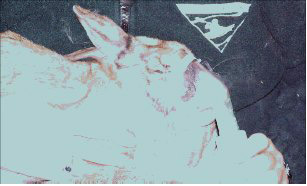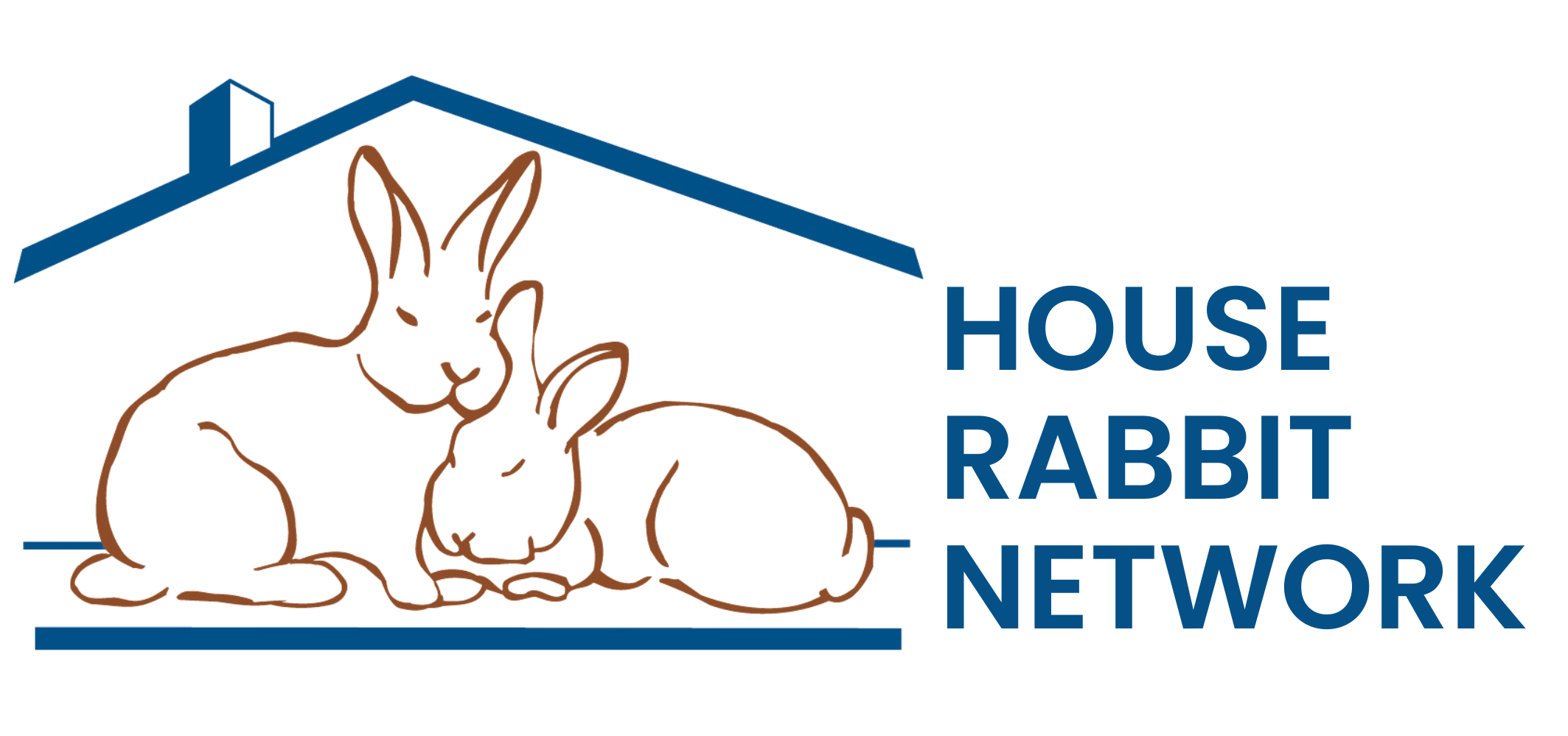Case Study: Guiness’ Nebulizer Treatments for Pneumonia

The first time I heard the noise I did not know what it was or from where it came. I then heard it again, and proceeded to follow the sound to a desk in the hallway. When I looked under the desk, I saw Guinness huddled by the wall and not moving. His breathing sounded like a percolator making coffee. I will never forget that crackling sound!
Several years ago, I adopted Guinness from the House Rabbit Network after my female rabbit, Blue, chose him as her new companion, it was love at first sight! He is a sweet, loving, beautiful rabbit who has this delightful habit when I stop petting him of gently picking up my fingers in his mouth to coax me back for more pets.
That morning before I left, Guinness was his usual self. He had begged for a raisin, eaten his parsley and beet greens, and was lying with Blue on the carpet in front of a sunny window in the dining room. There appeared to be no warning of what was to come later that day. In hindsight, I believe he was already having difficulty breathing yet he was able to hide it quite convincingly. This was my first lesson on how well bunnies, as vulnerable prey animals, can conceal their illnesses.
When I found Guinness that afternoon, both the noise he was making and the fact that he was under the desk surprised me. He had never gone under any piece of furniture before. I moved the desk and gently lifted him up. When I held him close, I became aware that he was having considerable difficulty breathing and getting enough air. He did not try to stand up or move. Later, when he did try to stand up, he would immediately lie back down, as the exertion was too much for him with so little oxygen in his body.
After rushing him to the local veterinary hospital, Guinness was officially diagnosed as having pneumonia. The veterinarian who examined him prescribed oral baytril and gave him an injection of the same medication during the office visit. I took Guinness home but over the next couple of days, he showed little improvement. A different antibiotic was prescribed yet he continued to be very congested, with no discharge, and was still not getting enough oxygen to be able to stand for more than a few seconds. Guinness’ veterinarian informed me that nothing more could be done.
In desperation, I called Suzanne at The House Rabbit Network for help. She related to me that although she had never personally done a nebulizer treatment and did not know much about them, she had heard of rabbits with pneumonia recovering after receiving the treatments. Determined not to give up hope and help Guinness in any way that I could, I began an internet search for information where I learned that nebulizer treatments were recommended as a treatment for both upper and lower respiratory infections in rabbits.
I spoke with Guinness’ veterinarian about nebulizer treatments and after some research, he concluded that we should try it. These treatments can be given along with systemic antibiotic therapy in the veterinarian’s office, or at home. Since I did not want to stress Guinness with the twice-daily vet visits, I decided to try the treatments at home but first I needed to purchase a nebulizer. I knew the initial expense would be high, around $200.00, but considering the cost of continued veterinary appointments, I felt it would eventually pay for itself. In speaking with the local pharmacist, I was surprised to hear that any customer with a prescription for nebulizer medications could use the nebulizer machine for as long as needed free of charge, although this may not be true at all pharmacies.
The veterinarian prescribed saline and gentomycin for the nebulizer treatments, and the pharmacist showed me the nebulizer, how to use it, and recommended that I use a child’s mask attached to the machine for Guinness. I paid only for the medications and a few dollars for the mask. The nebulizing machine consisted of an air compressor, a hose to transport the air and a compartment near the end of the hose where the mask is attached for the medication. The mist dispensed by the nebulizer is inhaled by the rabbit so that the medication is delivered more directly to the site of the infection in the sinuses, nose, lungs and bronchial passages. Treatments were twice a day and each one was about 15 to 20 minutes long, or enough time for the medication mixture to work through the compressor. The process was finished when the cup was empty and there was no more mist.
I returned home ready to begin. After filling the cup with the prescribed amounts of saline and gentomycin, I attached the child’s mask to the end of the hose. I sat on the sofa with Guinness in my lap and placed the child’s mask over his face holding it there as I turned on the nebulizer. The machine was noisy, and initially he was startled but soon he settled down, closing his eyes and becoming relaxed and calm. Talking and singing to Guinness also appeared to help soothe him. A very light mist filled the chamber of the child’s mask that was placed around his nose allowing most of the vapor to stay within the mask for him to breathe in. Since then I have learned that an enclosed chamber can also be utilized to nebulize bunnies, however I found that using a mask ensured that more of the medicine made its way into Guinness’ airways. At the end of the treatment when the mask was removed, his nose and the surrounding fur was damp. I believe these treatments made him feel better thereby aiding in his willingness to tolerate them.
The gentomycin seemed to help him breathe more easily and receive additional oxygen, yet he still made that same crackling sound when breathing and he could only walk a few feet before collapsing on the floor. I called the veterinarian and he decided to add aminophylline and mucomyst to the gentomycin and saline nebulizer treatment. The aminophylline is a bronchiodilator that opens the airway and the mucomyst works synergistically with it by breaking up the mucous blocking the bunny’s airway. I carefully followed the recipe to ensure that the right proportions of medications were used. Within the first twentyfour hours of medication change there was a dramatic improvement in Guinness’ ability to breathe. The new combination of medications proved to be much more effective than gentomycin was alone.
Guinness steadily improved over the next several days, and within a week, he had recovered entirely from his pneumonia although his strength and energy returned slowly. Three weeks after the last nebulizer treatment, I was both relieved and very happy to see him acting completely normal again.
What a delight it was to watch him playing with the cat, begging for treats, exploring and running around the house. On several occasions, I even found him on the window seat lying in the sun. It had been a long time since he had the energy to jump that high! I firmly believe that the nebulizer treatments were the deciding factor in saving Guinness’ life. I hope that his experience can, in some way, help other bunnies with similar difficulties, breathe a little more easily.
by Lorraine Howard
